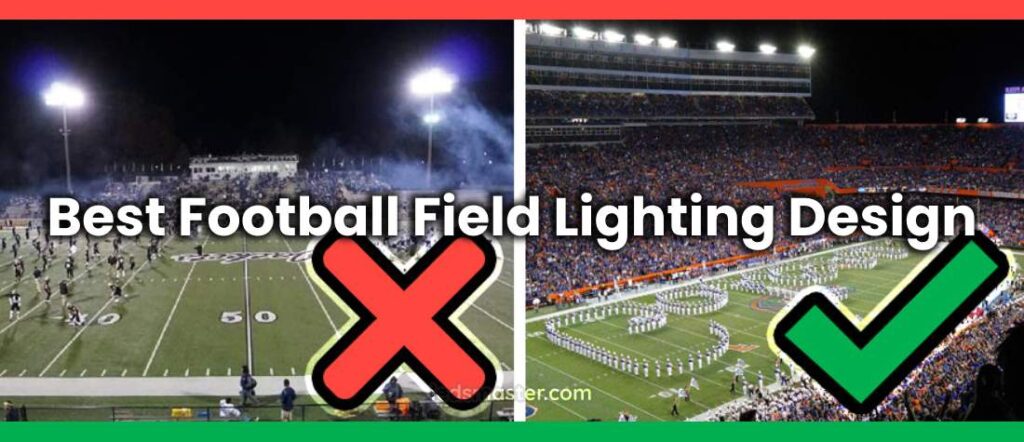We provide complimentary lighting design services for football fields, also known as soccer pitches, tailored to meet various standards including those for recreational play, high school games, college matches, professional leagues, and international tournaments.
Our LED stadium lighting solutions are designed to meet the stringent standards set by FIFA, the Premier League, and the Olympic Games. Our skilled engineers employ advanced software such as DIALux and RELUX to craft optimal lighting solutions and generate comprehensive photometric analysis reports. In addition to advising on the ideal placement of outdoor luminaires, we offer insights into common pitfalls to help you avoid costly mistakes. Effective planning is essential for securing lighting tenders and achieving successful outcomes.
Table of Contents
ToggleLighting Requirements for Football Fields
Selecting the right floodlights for football fields is essential for optimal performance and visibility. Understanding the specific lighting requirements can help ensure that the chosen lighting solutions meet the needs of various types of football events. Here’s an in-depth guide to assist in making the best choice for your lighting needs.
Lux Levels (Brightness) for Football Stadiums
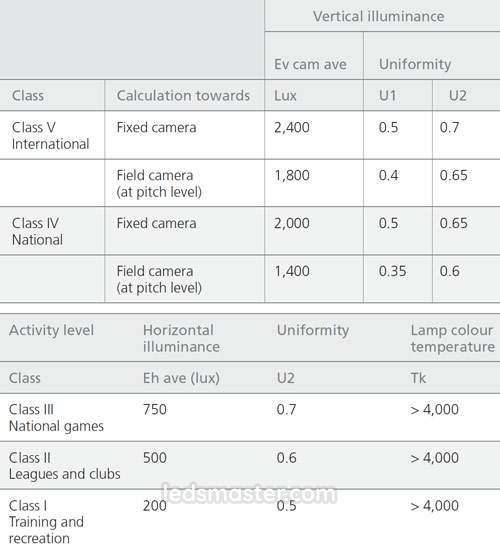 The lux levels, or brightness requirements, for football stadiums are determined by the level of play and whether the games are televised. According to FIFA’s guidelines, there is a considerable difference in the brightness levels required for different scenarios.
The lux levels, or brightness requirements, for football stadiums are determined by the level of play and whether the games are televised. According to FIFA’s guidelines, there is a considerable difference in the brightness levels required for different scenarios.
For international televised events, such as those in the World Cup (Class V), the lighting standards are quite stringent. These events require a vertical lux level of 2400 lux, which focuses on illuminating the players’ faces, and a horizontal lux level of 3500 lux, ensuring the entire pitch is adequately lit. These high standards are essential for delivering clear, high-quality broadcasts and maintaining the performance quality of the players.
On the other end of the spectrum, community or recreational football fields have significantly lower lighting requirements. For such fields, a lux level of around 200 is generally sufficient to facilitate safe and enjoyable play. This level of lighting supports casual games and training sessions without the need for high-intensity illumination.
High school and college football fields fall somewhere in between. Typically, these fields require a lux level of 500 to provide adequate lighting for competitive matches and practice sessions. This ensures that players have enough visibility to perform effectively while maintaining safety on the field.
Uniformity Standards
Uniformity in lighting is a critical factor in ensuring that the entire football field is evenly illuminated. This metric, which ranges from 0 to 1, measures how consistently light is distributed across the field. It is assessed through two primary ratios: the ratio of minimum illuminance to average illuminance (U1) and the ratio of minimum to maximum illuminance (U2).
For example, if the lux levels across the field are consistently between 650 and 700 lux, the uniformity will be close to 1, indicating minimal variation between the minimum and maximum light levels. Achieving such uniformity ensures that players and officials experience consistent lighting conditions throughout the game, which is crucial for maintaining performance and safety.
FIFA’s standards for football stadiums demand a uniformity ratio of 0.7. This requirement presents a significant challenge, as it necessitates careful planning and precise installation to avoid hotspots and shadows. Meeting this standard is essential for high-level competitions, where even lighting contributes to the quality of play and viewer experience.
Color Temperature
Color temperature is another important consideration for football field lighting. The recommended color temperature for football fields is generally above 4000K across all levels of play. This temperature range provides a cool, white light that closely resembles daylight, which is beneficial for visibility and color rendering.
For enhanced performance and a more dynamic environment, a color temperature between 5000K and 6000K is often preferred. Lights in this range offer even better illumination, creating a vibrant atmosphere for both players and spectators. Cooler white lights are not only more energizing but also improve the contrast and clarity of the playing surface, making it easier for players to track the ball and for spectators to follow the action.
Football Field Lighting Design
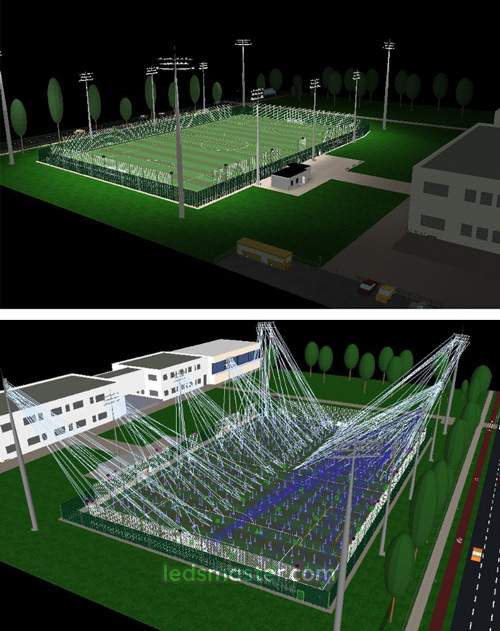 Designing lighting for football fields, also known as photometric analysis, requires a meticulous and multi-faceted approach to achieve optimal illumination. This process involves several key considerations, including the size of the field, its height, location, the number of light poles, and specific requirements for illuminance levels and lighting uniformity. Engineers adhere to a structured methodology to effectively plan and implement the lighting system.
Designing lighting for football fields, also known as photometric analysis, requires a meticulous and multi-faceted approach to achieve optimal illumination. This process involves several key considerations, including the size of the field, its height, location, the number of light poles, and specific requirements for illuminance levels and lighting uniformity. Engineers adhere to a structured methodology to effectively plan and implement the lighting system.
Creating the Football Field Model
The first step in the process involves creating a detailed model of the football field. This is accomplished using DIALux, a robust and free software tool designed for lighting design. DIALux is capable of modeling a wide range of indoor and outdoor sports facilities, including football fields, tennis courts, and badminton courts, through its diverse templates. The designer starts by inputting the precise dimensions of the field into the software, followed by the integration of light poles with specified measurements. This simulation is crucial as it provides a realistic representation of the field and the placement of lighting fixtures, enabling a more accurate assessment of how the lights will perform in a real-world scenario.
Planning the LED Flood Lights
Following the creation of the field model, the next phase involves the planning and integration of LED flood lights. The lighting engineer uses DIALux to position the luminaires within the model. The software allows for the exploration of various combinations of power levels, lumen outputs, and beam angles. Each combination can produce different lighting outcomes, making it essential to identify the optimal configuration for the football field. Since each project presents unique challenges and requirements, the lighting design is customized to address the specific needs of the field, ensuring that the lighting setup is perfectly suited to the environment and usage.
Generating the Photometric Analysis Report
The final step is to generate a comprehensive photometric analysis report. This report provides a detailed overview of the lighting design and its effectiveness. It includes several critical elements such as the value chart, which illustrates the lux levels across the field, offering an overall understanding of the brightness distribution. Additionally, isolines are used to connect areas with equal illuminance, helping to visualize regions with consistent lighting. The false color rendering provides an intuitive graphical representation of brightness variations, highlighting differences in illumination across the field. This detailed analysis ensures that all aspects of the lighting design are thoroughly evaluated, allowing for adjustments and refinements to meet the highest standards of performance and safety.
Common Mistakes to Avoid When Designing Sports Lighting
To enhance the quality and effectiveness of your sports lighting design, it is crucial to avoid several common pitfalls that can impact performance and safety. Here are key mistakes to watch out for:
Avoiding Light Pollution
Sports stadiums often utilize high-intensity LED lights, ranging from 60,000 to 100,000 watts. Without proper control, excessive light spill can negatively affect the quality of life for nearby residents. Glare from poorly managed lighting can also impair the vision of drivers and pedestrians, posing significant safety risks.
To address this issue, it is essential to select LED stadium lights equipped with anti-glare features and precise optical systems. These technologies focus light on the intended areas, minimizing light loss and reducing spillover. Additionally, choosing floodlights with narrower beam angles ensures that light is more concentrated and directed where it is needed most.
Considering the Lifespan of the Luminaire
One common oversight in sports lighting design is neglecting the longevity of the luminaires. A lighting solution with a longer service life offers substantial benefits, including reduced maintenance costs and fewer replacements. LED lights with a lifespan exceeding 20 years are particularly advantageous for stadium owners, as they decrease the frequency of replacements and associated expenses.
Our LED lights are designed to last for up to 80,000 hours, which translates to approximately 27 years if used for 8 hours each day. This extended lifespan ensures long-term reliability and cost-efficiency for stadium lighting.
Addressing Flickering Issues
Flickering is a significant concern, especially in football stadiums hosting international, televised events. Proper lighting design must account for the potential for flicker, which can adversely affect slow-motion camera footage and overall viewer experience. Strobing lights can distort playbacks and make the stadium appear unprofessional.
Our sports field lights are specifically engineered to meet high-speed camera requirements, with a flicker rate of less than 0.3%. This low flicker rate adheres to international broadcasting standards, ensuring clear and stable footage for audiences and maintaining a professional appearance for the stadium.
Stadiums with Excellent Lighting Systems
Numerous football stadiums around the world are celebrated for their exceptional lighting systems, which significantly enhance both the playing experience and spectator enjoyment. These venues not only showcase cutting-edge lighting technology but also reflect architectural brilliance. Here’s an in-depth look at some of the most renowned stadiums known for their outstanding lighting design and features:
AT&T Stadium
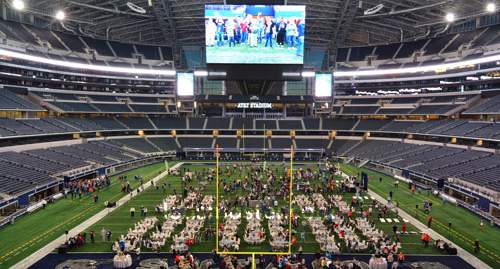 Located in Arlington, Texas, AT&T Stadium is a marvel of modern architecture and lighting design. This massive venue, accommodating up to 80,000 spectators, features a retractable roof and operable glass doors that contribute to its versatility. The lighting system at AT&T Stadium is designed to provide near-perfect illumination, employing nearly 360° of high-power flood lamps. This configuration ensures shadowless lighting across the field, which is crucial for both daytime and nighttime games. The stadium’s lighting not only enhances visibility but also supports the venue’s reputation as one of the premier NFL stadiums, making it a top choice for major events and broadcasts.
Located in Arlington, Texas, AT&T Stadium is a marvel of modern architecture and lighting design. This massive venue, accommodating up to 80,000 spectators, features a retractable roof and operable glass doors that contribute to its versatility. The lighting system at AT&T Stadium is designed to provide near-perfect illumination, employing nearly 360° of high-power flood lamps. This configuration ensures shadowless lighting across the field, which is crucial for both daytime and nighttime games. The stadium’s lighting not only enhances visibility but also supports the venue’s reputation as one of the premier NFL stadiums, making it a top choice for major events and broadcasts.
Anfield Stadium
Home to Liverpool FC, Anfield Stadium is renowned for its electric atmosphere, especially during European nights. With a capacity of approximately 54,000, Anfield is a cornerstone of football culture in the UK. The stadium’s lighting system is equipped with over 200 sets of 400-watt LED lights, achieving a high Color Rendering Index (CRI) of 85. This ensures superior visibility for Premier League matches and contributes to the stadium’s iconic status. The high-quality LED lights enhance the overall match experience, providing clear and vibrant illumination that complements the stadium’s passionate atmosphere.
San Siro Stadium
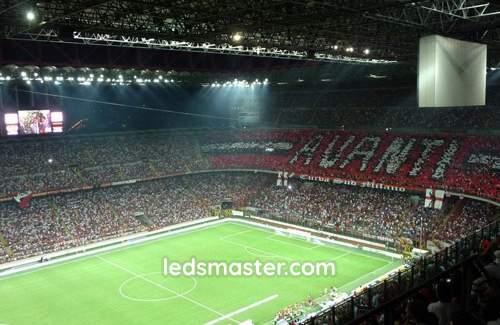 San Siro, situated in Milan, Italy, is a historic football venue with a capacity of around 80,000. Known for its architectural significance and stunning views, San Siro offers exceptional visibility due to its advanced lighting design. The stadium features over 60,000 watts of LED lighting, which delivers super-bright illumination across the pitch. This setup ensures consistent and clear visibility from all seating areas, enhancing the spectator experience and making San Siro a favorite among football fans and a must-visit destination.
San Siro, situated in Milan, Italy, is a historic football venue with a capacity of around 80,000. Known for its architectural significance and stunning views, San Siro offers exceptional visibility due to its advanced lighting design. The stadium features over 60,000 watts of LED lighting, which delivers super-bright illumination across the pitch. This setup ensures consistent and clear visibility from all seating areas, enhancing the spectator experience and making San Siro a favorite among football fans and a must-visit destination.
Victoria Stadium
Victoria Stadium, located in Gibraltar, provides a unique and picturesque setting for various sports and entertainment events. Positioned just off Winston Churchill Avenue, this versatile arena hosts football, cricket, and music performances. The stadium is distinguished by the prominent lump of rock that serves as a natural backdrop, adding to its visual appeal. On sunny days, the field’s beauty is accentuated, and the stadium’s lighting system enhances visibility during evening events. Victoria Stadium’s charm and versatility make it a popular venue for UEFA fans and a notable landmark in Gibraltar.
Osasuna Stadium
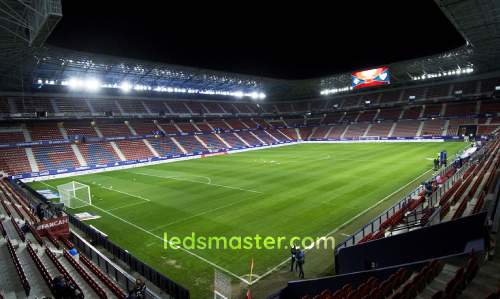 Officially known as El Sadar Stadium, Osasuna Stadium in Spain is celebrated for its exceptional football grounds and scenic location. With a capacity of approximately 23,500, the stadium is situated alongside a river, offering a picturesque setting for matches. The lighting system at Osasuna Stadium is designed to complement the expansive field, providing uniform illumination that enhances the match experience. The thoughtful lighting design ensures that fans enjoy a delightful viewing experience while maintaining the stadium’s aesthetic appeal.
Officially known as El Sadar Stadium, Osasuna Stadium in Spain is celebrated for its exceptional football grounds and scenic location. With a capacity of approximately 23,500, the stadium is situated alongside a river, offering a picturesque setting for matches. The lighting system at Osasuna Stadium is designed to complement the expansive field, providing uniform illumination that enhances the match experience. The thoughtful lighting design ensures that fans enjoy a delightful viewing experience while maintaining the stadium’s aesthetic appeal.
Allianz Arena
Allianz Arena, located in Munich, Germany, is famous for its visually dynamic lighting system. Home to Bayern Munich, the stadium features a façade that changes colors based on the team playing, creating a striking visual effect. The lighting system at Allianz Arena is designed not only to provide excellent illumination but also to enhance the stadium’s aesthetic appeal. The combination of high-quality lighting and the stadium’s unique color-changing façade makes Allianz Arena a major tourist attraction and an iconic football venue in European football.
Camp Nou
Camp Nou, located in Barcelona, Spain, is the largest stadium in Europe, with a capacity of 99,786. Home to FC Barcelona, Camp Nou is renowned for its retro architectural style and innovative lighting design. The stadium features translucent panels that allow for dynamic color displays, reflecting the colors of the teams and creating a visually engaging experience for spectators. The lighting system at Camp Nou is designed to offer both functional excellence and aesthetic appeal, making it one of the most iconic football venues in the world.
Emirates Stadium
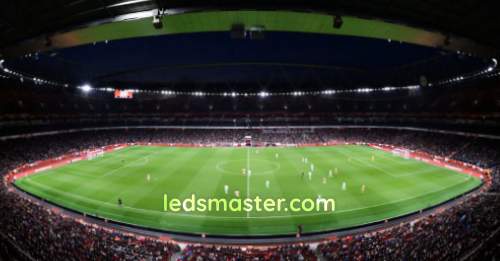 Emirates Stadium, the home of Arsenal FC in London, is known for its state-of-the-art lighting system. With a capacity of 60,000, the stadium is equipped with a sophisticated LED lighting setup that ensures uniform illumination and minimal glare. The design of the lighting system focuses on enhancing visibility for both players and spectators while maintaining the stadium’s modern and elegant aesthetic. The advanced lighting technology at Emirates Stadium contributes to a high-quality match experience and supports its reputation as a premier football venue.
Emirates Stadium, the home of Arsenal FC in London, is known for its state-of-the-art lighting system. With a capacity of 60,000, the stadium is equipped with a sophisticated LED lighting setup that ensures uniform illumination and minimal glare. The design of the lighting system focuses on enhancing visibility for both players and spectators while maintaining the stadium’s modern and elegant aesthetic. The advanced lighting technology at Emirates Stadium contributes to a high-quality match experience and supports its reputation as a premier football venue.
Estadio Azteca
Estadio Azteca in Mexico City is one of the most famous football stadiums in the world, known for its historic significance and impressive lighting system. With a capacity of 87,523, it has hosted numerous high-profile matches, including World Cup finals. The lighting system at Estadio Azteca is designed to accommodate large crowds and high-definition broadcasts, ensuring clear visibility and a vibrant atmosphere. The stadium’s lighting technology plays a crucial role in maintaining its status as a landmark in football history.
Tottenham Hotspur Stadium
Tottenham Hotspur Stadium in London is one of the newest additions to the list of top football venues. The stadium, with a capacity of 62,303, features a cutting-edge lighting system that includes high-quality LED lights and advanced control systems. The lighting design is tailored to enhance both the match experience and the stadium’s aesthetic appeal, making it a standout venue in English football. The innovative lighting technology supports the stadium’s multifunctional use, including NFL games and concerts.
Conclusion
Our complimentary lighting design services are tailored to meet the diverse needs of football fields, from recreational to international tournaments. Using advanced LED technology and sophisticated software, we provide optimal lighting solutions that meet stringent standards set by FIFA, the Premier League, and the Olympic Games. Our expert planning ensures precise illumination, enhancing visibility and performance while avoiding common pitfalls. With our commitment to excellence, we ensure your stadium stands out, delivering superior experiences for players and spectators alike.

